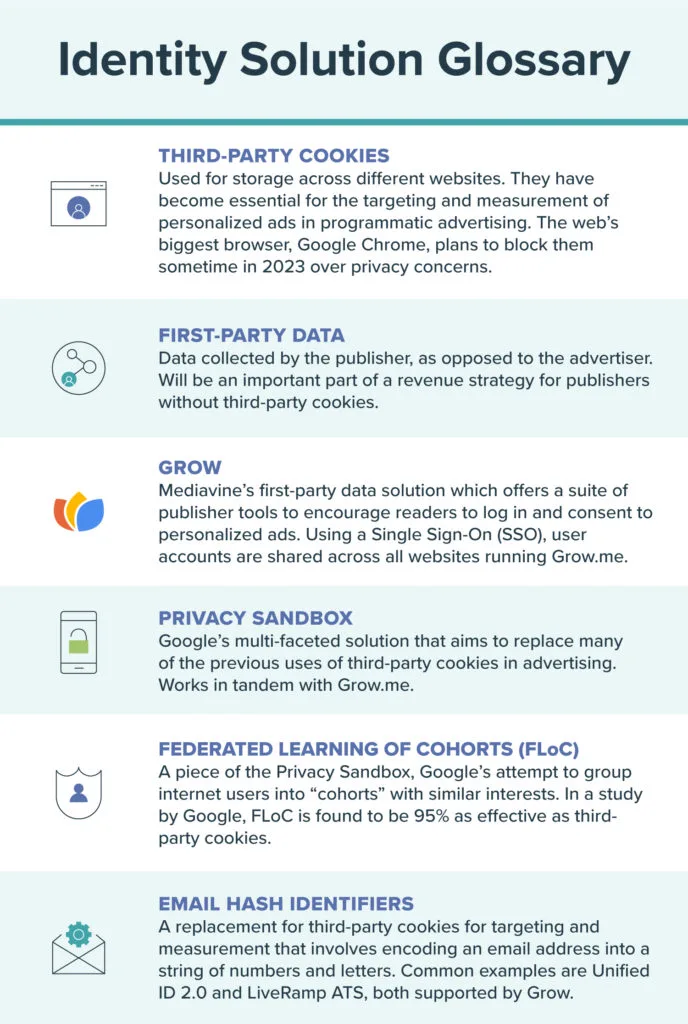Google Doubles Down on Privacy Sandbox and First-Party Data. That’s a Good Thing.


Recently, the Google Ads team sent shockwaves through the digital advertising world with a blog post about the privacy-first web.
While it contained some interesting thoughts on the new ecosystem we’re all trying to usher in, the article is actually not a huge deal.
Below, we’ll talk about why much of the industry reacted the way it did, how Google’s approach impacts Mediavine publishers and why you shouldn’t panic. In fact, you should be more confident than ever.
Google made three key announcements in its blog post, which we’re going to discuss.
Google is doubling down on the Privacy Sandbox, which should come as a shock to exactly no one. The architects and proponents of the Privacy Sandbox are, well, still proponents of the Privacy Sandbox.
With good reason. This is the company whose early FLoC testing found its cohorting methods to be 95% as effective as third-party cookies.
Google should be expected to hype its own products, especially given the promising early results. So why were people surprised?
For one, not everyone is as proactive as Mediavine.
Some industry players were probably hoping that Google might back down and either stick with third-party cookies or find workarounds that more closely resembled that type of tracking.
No such luck for anyone operating under those (misguided) hopes or assumptions. Cookies’ days are numbered on Chrome.
Personally, we see the Privacy Sandbox as preserving some level of ad personalization, targeting and measurement while preserving user privacy in ways that haven’t been prioritized until now.
It’s all a balancing act, but it’s headed in the right direction.

This part of the article in particular roiled more than a few people in ad tech. In its pledge not to track individual users, Google said that it won’t accept third-party identifiers based on email hashes.
Without naming names, this is a careful but clearly worded way of saying they’re not going to support Unified ID 2.0 and LiveRamp ATS.
You may recognize those two names thanks to their integrations with Grow, Mediavine’s user engagement suite and first-party data solution.
As the first publisher live with Unified ID 2.0, you might think Mediavine would be concerned or surprised by this statement.
Nope. Again, this should shock absolutely no one (even though it clearly has).
Google Ad Exchange (the Google SSP) and Google DV 360 (the Google DSP) have historically never accepted or used a third-party identifier in the open marketplace — not the original Unified ID 1.0 nor LiveRamp’s IDL — which have both been out for years.
There was no reason to think they would suddenly adopt 2.0 or LiveRamp now. However, despite confirmation of Google’s position, this week’s trade magazine reports of the untimely death of UID 2.0 and LiveRamp ATS are greatly exaggerated.
Remember, there’s a healthy ad ecosystem outside of Google on both the SSP and DSP side; both already work with or have pledged to work with LiveRamp and Unified ID 2.0.
These solutions have never been and were never going to be accepted by Google, so their blog post changed nothing. The future is bright for both, as we’ll discuss more in a little bit but first, one more point:
Some industry players interpret this week’s announcement as Google saying it won’t even track its own logged-in users. If that’s true, it’s great for independent publishers.
Google represents one of the largest pools of authenticated users, rivaling places like Facebook. If Google doesn’t take advantage of this, it creates a huge opportunity for publishers to capitalize on.
As always, digital marketers will always seek efficient paths to target their exact customers. Independent publishers with authenticated traffic will be in an increasingly strong position to fill this void.
This was the biggest takeaway in Google’s post and what Mediavine set as our highest priority for 2021 many months ago.
While the Privacy Sandbox and email hashing talk had the ad tech world abuzz, many observers overlooked the fact that Google shouted from the rooftops what we’ve been telling you for what feels like forever:
The future of our industry is first-party data.
Google won’t use things like LiveRamp and Unified ID 2.0 that Grow integrates with to help publishers generate authenticated traffic, but it encourages — and will use — other forms of first-party data.
The company writes:
“Developing strong relationships with customers has always been critical for brands to build a successful business, and this becomes even more vital in a privacy-first world. We will continue to support first-party relationships on our ad platforms for partners, in which they have direct connections with their own customers.”
When it comes to Grow and why Mediavine went all-in building our own first-party data solution, the above excerpt perfectly sums it up.
Grow is an engagement toolkit that builds enhanced web experiences which are the key to user consent and first-party data collection.

Step 1: Get users to consent to personalized ads
The key to any first-party data strategy is encouraging audiences to consent to personalized ads and, ideally, fully authenticate with an email address.
Grow has been building terrific features (e.g. save recipe, favoriting, recommended content, with many more in the pipeline) to help web publishers naturally encourage this user behavior.
Step 2: Unified ID 2.0 and LiveRamp ATS start the first-party data revolution
In the short term, as you encourage your readers to log in and consent to personalized ads via providing their email addresses, you can utilize Unified ID 2.0 and LiveRamp ATS.
Google may not embrace their email hashing, but as we said, much of the rest of the ecosystem will, and both of these solutions have significant spend behind them in the open marketplace.
Unified ID 2.0 and LiveRamp ATS are essential in providing the scale and performance that ultimately drive the majority of advertisers to a first-party data world and proving the ROI (return on investment) behind a first-party data strategy.
Step 3: Actually start generating first-party data yourself
Any reader who logs into your site through Grow is actually helping you authenticate traffic and making you more money.
But the broader goal, which goes far beyond that, is that Grow will begin helping publishers collect data in the future.
Whether that’s demographics, interest groups, contextual or whatever else the market shifts to, Grow will be uniquely positioned as an expansive platform — one reaching across thousands of domains with authenticated readers consenting to personalized ads.
But the important thing with all three steps is starting now. This isn’t some theoretical roadmap; it’s happening today.
While others talk about the end of cookies and importance of first-party data in the abstract, we’ve built a solution years ahead of the curve.
The web has always been a fast-changing and dynamic experiment. We are now entering a phase where user privacy is no longer an afterthought — solutions must be architected with this goal in mind.
While any shift of this magnitude can be unsettling, we see the coming years as an opportunity to help shape a more secure, open, efficient advertising marketplace through Grow and our amazing partners.
In its blog post, Google has effectively stated that its priorities are aligned with Mediavine and Grow on every front.
In uncertain times like these, that’s something to feel good about.
Stay up to date with the latest from Mediavine
Welcome to the much-anticipated release of the fifth-annual edition of “The Best eCPM Days of the Year” calendar. Each year, we analyze historical trends to provide publishers with a graphical …
“Let’s talk about politics.” We know. This is a phrase absolutely no one wants to hear uttered around the dinner table or backyard barbecue these days. But hear us out. …
Ah, July. It’s a glorious month of sand-filled swimsuits, mosquito invasions, broken air conditioners and applying sunscreen only to look like cooked lobsters. It’s also the start of a new …